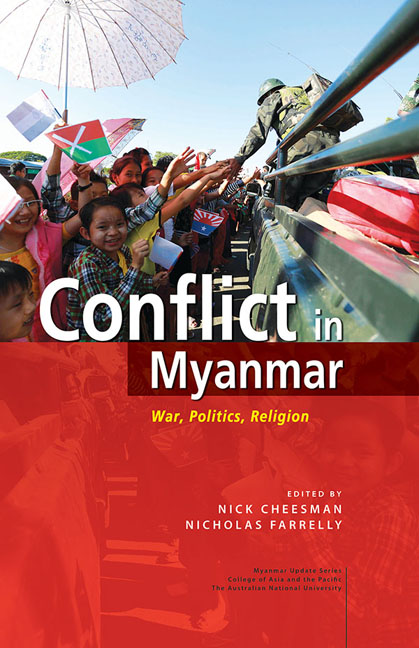Book contents
- Frontmatter
- Contents
- List of Maps
- List of Tables
- List of Figures
- Acknowledgements
- Contributors and Editors
- Part I Introduction
- Part II War and Order
- 2 The politics of policymaking in transitional government: A case study of the ethnic peace process in Myanmar
- 3 Reexamining the centrality of ethnic identity to the Kachin conflict
- 4 A feminist political economy analysis of insecurity and violence in Kachin State
- 5 Pacifying the margins: The Pa-O Self-Administered Zone and the political order in southern Shan State
- 6 Landmines as a form of community protection in eastern Myanmar
- Part III Elections and After
- Part IV Us and Them
- Part V Conclusion
- Abbreviations and Key Terms
- Index
5 - Pacifying the margins: The Pa-O Self-Administered Zone and the political order in southern Shan State
from Part II - War and Order
Published online by Cambridge University Press: 22 July 2017
- Frontmatter
- Contents
- List of Maps
- List of Tables
- List of Figures
- Acknowledgements
- Contributors and Editors
- Part I Introduction
- Part II War and Order
- 2 The politics of policymaking in transitional government: A case study of the ethnic peace process in Myanmar
- 3 Reexamining the centrality of ethnic identity to the Kachin conflict
- 4 A feminist political economy analysis of insecurity and violence in Kachin State
- 5 Pacifying the margins: The Pa-O Self-Administered Zone and the political order in southern Shan State
- 6 Landmines as a form of community protection in eastern Myanmar
- Part III Elections and After
- Part IV Us and Them
- Part V Conclusion
- Abbreviations and Key Terms
- Index
Summary
On 28 August 2014, a lieutenant colonel of the Restoration Council of Shan State/Shan State Army — South (RCSS/SSA-S) inspected land on top of a mountain he bought less than a year before for about US$10,000. The land has a commanding view of Taunggyi and Lake Inle. He said with excitement that a general in Yangon recently bought a similar plot adjacent to his for US$150,000. He added that once he had sufficient money, he would develop the site into a hotel. On the way back to Taunggyi town centre, his Toyota four-wheel drive was stopped by traffic police at an ad hoc checkpoint. He lowered the tinted glass and the police immediately recognized him. After exchanging a few words, the police made an apologetic gesture and waved the car on. The lieutenant colonel explained that they were stopping cars to fine those without the necessary permit. They stopped him because they did not know he had changed his car.
The lieutenant colonel is well known in town because he helped broker a ceasefire agreement between the RCSS/SSA-S and the central government. Before signing the agreement in 2011, the RCSS/SSA-S was one of the major ethnic armed groups in the country (Keenan 2012). In April 1988 the officer was a summer school teacher in Taunggyi and only planned to stay there until the end of classes. However, he was caught up in the student protests and arrested, according to him, simply because he was in the wrong place at the wrong time. He was released after three months in prison. While there he began to understand the struggles of the ethnic minorities and was sympathetic to them. After his release, he joined the SSA together with five other teachers who had been arrested at the same time. He fought in the jungles and eventually rose to the rank of lieutenant colonel. In 2005 he was seriously ill, so he left the SSA and went to China for treatment. He returned to Taunggyi after he recovered. In 2010 when the RCSS/SSA-S began ceasefire talks with the government, his former superior called him to lead the negotiation team, probably because he was the most educated person they could trust.
- Type
- Chapter
- Information
- Conflict in MyanmarWar, Politics, Religion, pp. 91 - 120Publisher: ISEAS–Yusof Ishak InstitutePrint publication year: 2016

